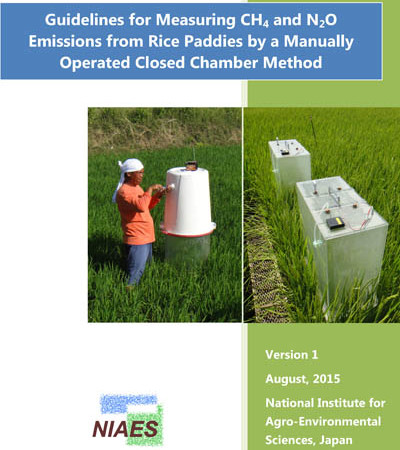
Preface
Since Prof. Ralph J. Cicerone and his colleagues have covered rice plants with gas collectors at an experimental rice field located in the University of California at Davis in the late summer of 1980, closed chamber methods have been used for measuring methane emissions from rice paddies at numerous paddy fields in various parts of the world. The database used for estimating emission and scaling factors for methane from rice cultivation in the 2006 IPCC Guidelines compiled more than 1000 data of seasonal measurements by closed chamber methods at over 100 different sites in 8 Asian countries. Closed chamber measurements are being conducted at various paddy fields in these and other countries up to the present date, in order to study mechanisms of material cycling in the ecosystems or to estimate specific emission factors for developing a greenhouse gas inventory.
The research community doing these measurements often discuss about identifying both “best practice” and gaps in the current methodologies of measuring gas emissions, because inter-comparisons of the methods used among different research groups are limited and assessment of the reliability and uncertainty associated with the results have not been comprehensively discussed. The need for standardized guidelines for measuring greenhouse gas emissions from rice paddies have been recognized from these discussions.
The United Nations Framework Convention on Climate Change (UNFCCC) has introduced in the Bali Action Plan in 2007, the actions and commitments of measuring, reporting and verification (MRV), which is now recognized to be one of the most important building blocks to reduce greenhouse gas emissions from different sources. The MRV framework encompasses submitting national greenhouse gas inventories, undergoing international consultation and analysis, and setting up nationally appropriate mitigation actions (NAMAs). For implementing MRV at the local and national levels, standardized guidelines for measuring, and also for reporting and verifying, greenhouse gas emissions are strongly requested to be provided. The methodology registered for Methane emission reduction by adjusted water management practice in rice cultivation at the UNFCCC Clean development mechanisms (CDM) recommends to carry out measurements using the closed chamber method by providing simple Guidelines for measuring methane emissions from rice fields.
This document, “Guidelines for Measuring CH4 and N2O Emissions from Rice
Paddies by a Manually Operated Closed Chamber Method”, is a product of discussions in the international science communities, especially that in the Paddy Rice Research Group of the Global Research Alliance on Agricultural Greenhouse Gases (PRRG-GRA) since it was established in 2011. Much of the style and composition of the document follows the preceding publication by the Livestock Research Group of GRA, “Nitrous Oxide Chamber Methodology Guidelines”.
As mentioned in the Introduction section of the text, the guidelines have been developed to provide “recommended” protocols based on current scientif ic knowledge. We tried to provide as much scientific evidences that support the recommendations as possible. In addition, we tried to provide a user-friendly structure of the document by conveying practical and technical “know-how,” and defining minimum requirements for the measurements. Nevertheless, there still exist some gaps and uncertainties of the methodologies mainly due to current lack of our knowledge. Therefore, we hereby publish this document as version 1, or best practices at this moment, and hope to make revisions in the future by collecting further knowledge and experiences.








